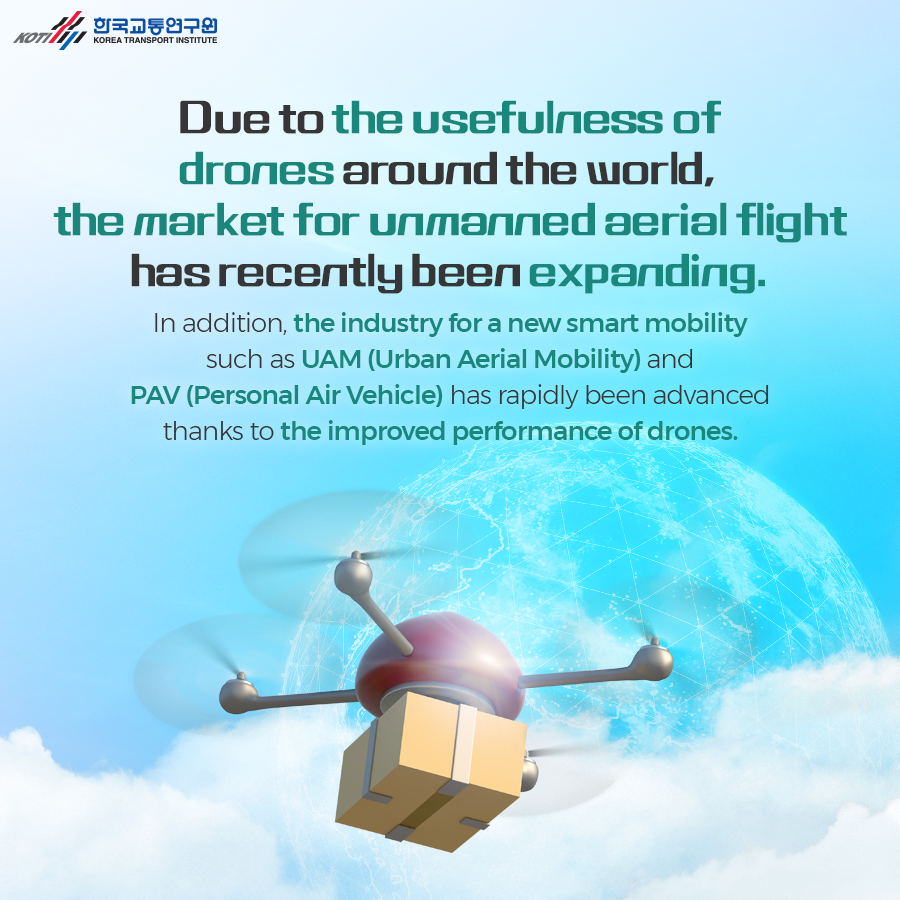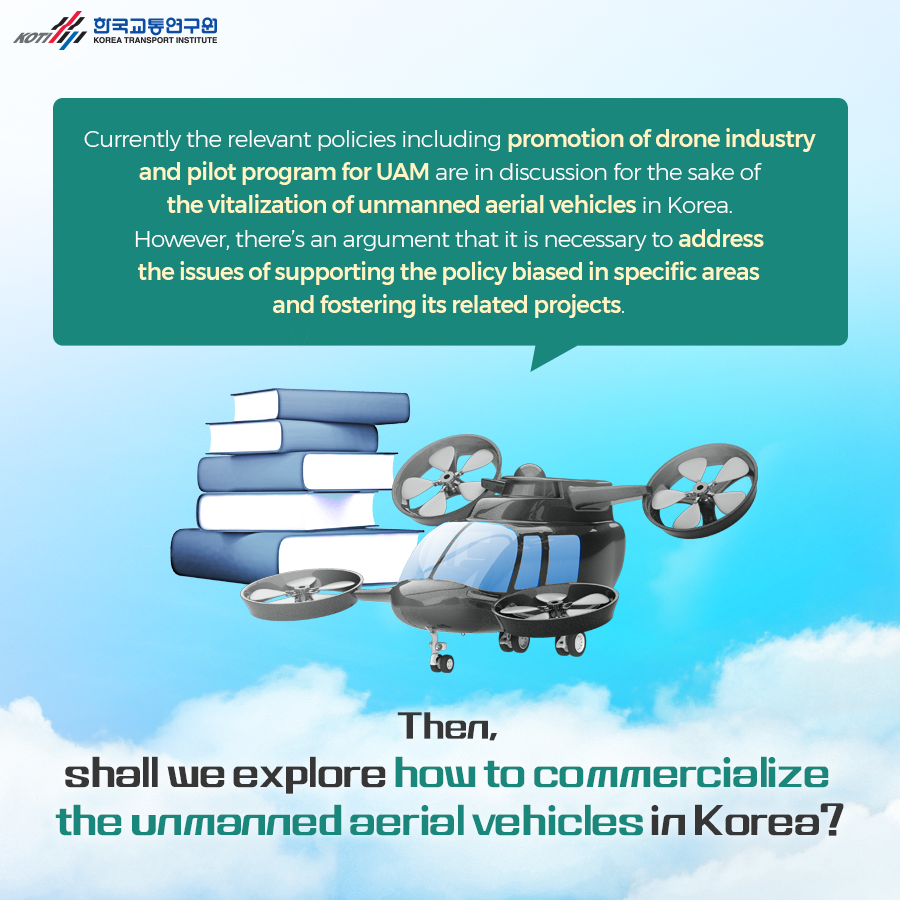Card News

NEWS
KOTI - Korea Transport institute-
When will UAM (unmanned aerial vehicle) be commercialized?
Due to the usefulness of drones around the world, the market for unmanned aerial flight has recently been expanding.
In addition, the industry for a new smart mobility such as UAM (Urban Aerial Mobility) and PAM (Personal Aerial Mobility) has rapidly been advanced thanks to the improved performance of drones.
Currently the relevant policies including promotion of drone industry and pilot program for UAM are in discussion for the sake of the vitalization of unmanned aerial vehicles in Korea.
However, there’s an argument that it is necessary to address the issues of supporting the policy biased in specific areas and fostering its related projects.
Then, shall we explore how to commercialize the unmanned aerial vehicles in Korea?
Policy for Commercialization of UAV
Advent of small-sized logistics using drones, the small unmanned aircrafts ➡ Commercialization of transportation industry by UAM in progression ➡ Expectation for the vitalized freight and passenger transportation via the pilotless unmanned aircrafts in the foreseeable future
Status of Law, System and Government Organizations
Majority available support is for the transportation via aircrafts with pilots in ➡ Lacks in supporting and fostering the industry for the transportation via unmanned aerial vehicles
Ambiguity of Legal Terms and Conflicted Issues
Definition of Unmanned Aerial Vehicles
Unmanned Aerial Vehicle in Korea: The aircraft which is remotely controlled for flying
ICAO (International Civil Aviation Organization): The aircraft to fly without pilots in ➡ Issue: Expanded and reproduced confusion in related departments, industry, academia and research sectors due to vague terms
Direction of Improvement in Policy
Integrated control of laws and systems related to unmanned aerial vehicles / Establishment of legal foundation for safe flight / Unification of mixed definitions in association with unmanned aerial vehicles (including drones etc.)
Operations for Commercialization of Unmanned Aerial Vehicles
UTM (UAS Traffic Management) Research for Traffic Controls: Unmanned Aerial System Traffic Management System is in development
Establishment of Operational Concept for UAM 1.0: Considering infrastructures such as a vertiport and frequency etc. of UAM for taking off and landing ➡ Issue: The issues need to be sorted out e.g. C2 link used by RPAS, the procedures for the integrated operation of manned/unmanned aerial vehicles and the qualifications of workers at unmanned aerial vehicle sectors
Direction of Improvement in Operation
Establishing the systematic operational concepts for entire unmanned aerial vehicles and securing communication / technical standard for C2 link
Building the operational facilities and preparing for technical standards for safe flight
Preparing for the updated procedures of air traffic control for integrated operation of manned / unmanned aircrafts
Preparing for a variety of qualification system and training programs for unmanned aerial vehicles
Domestic Market Trends for UAV and Measures for Improvement
Market Trends: The size of private market is expected to be expanded gradually thanks to the vitalized drones and UAM.
Improvement Measures: Research for Expansion of UAV market / Development of Strategy for More Freight Transportation / Strategy for Convergence of Existing Industries / Strategy for fostering logistics industry
Issues with Technology for Commercialization of UAV
Issue: The airworthiness for pilot’s boarding on the unmanned aircraft and for the system such as C2 link is required.
Direction of Improvement: Certification system for manned aircrafts or domestic certification that is equivalent to the airworthiness standard for foreign unmanned aircrafts / Introduction of Risk-based Approach assessment system for the airworthiness standards setting / Technical standards in consideration of pilot’s boarding at early stage of unmanned aircraft operation / BASA (Bilateral Aviation Safety Agreement) for unmanned aircrafts
Introduction of Procedures
Issues with R&D sectors
Issue: First unmanned aircraft related research in 2011 ➡ Research in progression mainly on some unmanned aerial vehicles
Direction of Improvement: Operational expert training / Development of new technology in association with some unmanned aircrafts and expanded investment for R&D / Expansion of region, infrastructure and public service for the pilot program of unmanned aircraft development
As the volume of logistics has rapidly grown due to the popularization of air transportation industry, Korea is getting more reputation enough to take 8th place in the world in terms of international and domestic air transport sales in 2019
Now It’s time to systematically prepare a variety of policy plans for Korea’s unmanned aerial vehicle transportation industry and the manned aircraft transportation industry as well.
* This card news is produced by modifying and supplementing the basic research report ‘Research for Development Strategy of Unmanned Aerial Vehicle Industry’.












